


Views: 0 Author: Site Editor Publish Time: 2025-09-16 Origin: Site









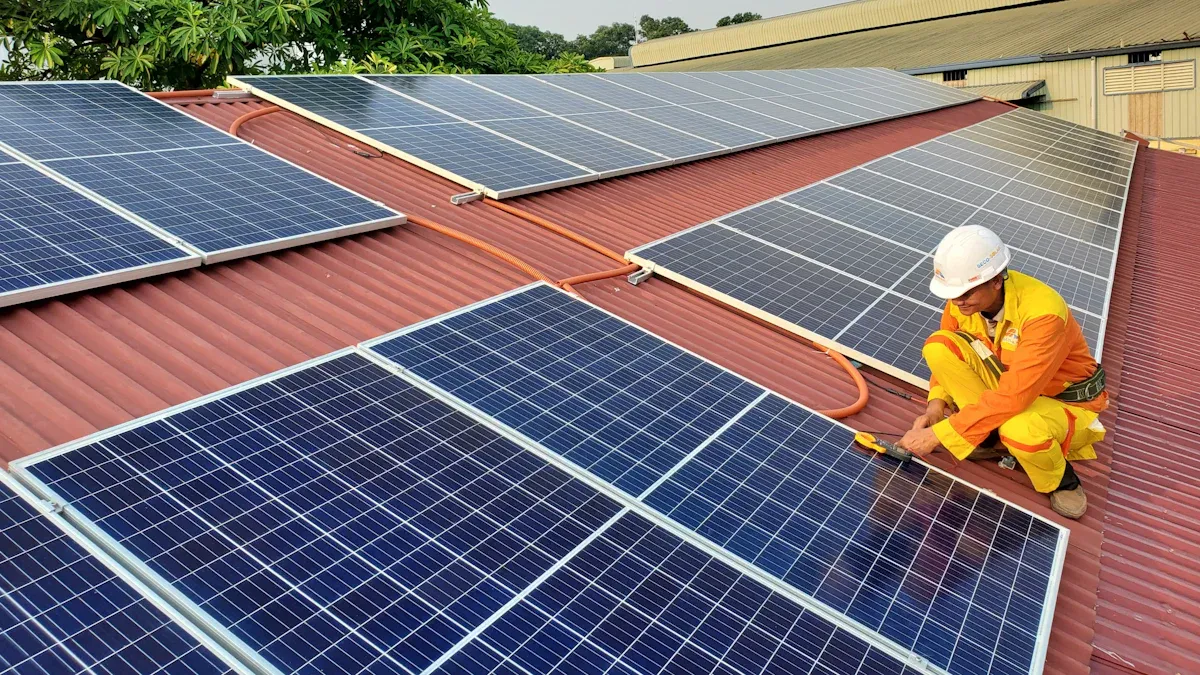
If you want to know the average cost of solar panels in 2025, you’ll likely pay between $2 and $3 per watt. Many homeowners see total prices from $12,500 to $36,000, depending on where you live and how big your system is. For example, a 7.2 kW system costs about $21,816 before incentives and drops to $15,271 after the federal tax credit. Check out how prices compare in different states:
State | Avg. Size (kW) | Cost Before Incentives | Cost After Tax Credit | Cost per Watt |
|---|---|---|---|---|
California | 5.9 | $20,840 | $14,588 | $3.33 |
Florida | 8.4 | $23,351 | $16,346 | $2.61 |
Illinois | 7.3 | $24,265 | $16,986 | $3.14 |
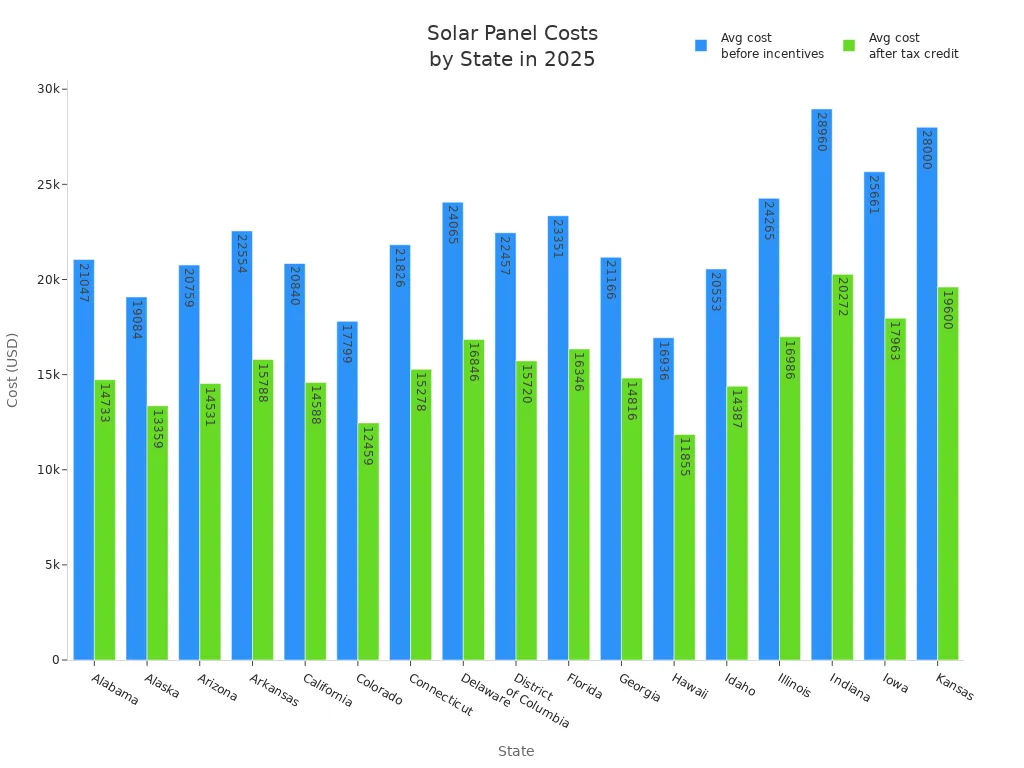
In 2025, solar panels cost $2 to $3 per watt. The total price for a system is $12,500 to $36,000. Bigger solar systems give you better value. The cost per watt goes down as the system gets bigger. Where you live changes the price of solar panels. Sunny states like Arizona and Texas have lower prices. This is because they have better weather for solar panels. Federal tax credits can cut your solar costs by 30%. This makes solar panels cheaper for you. Each year, solar panel maintenance costs about $520. You should plan for this to keep your panels working well. Solar panels usually pay for themselves in 9 to 12 years. You can save about $1,500 each year on your electric bill. It is important to compare quotes from different installers. Look at the equipment, warranties, and what services are included. When you buy can also help you save money. Buying early in the year can give you more incentives and savings.
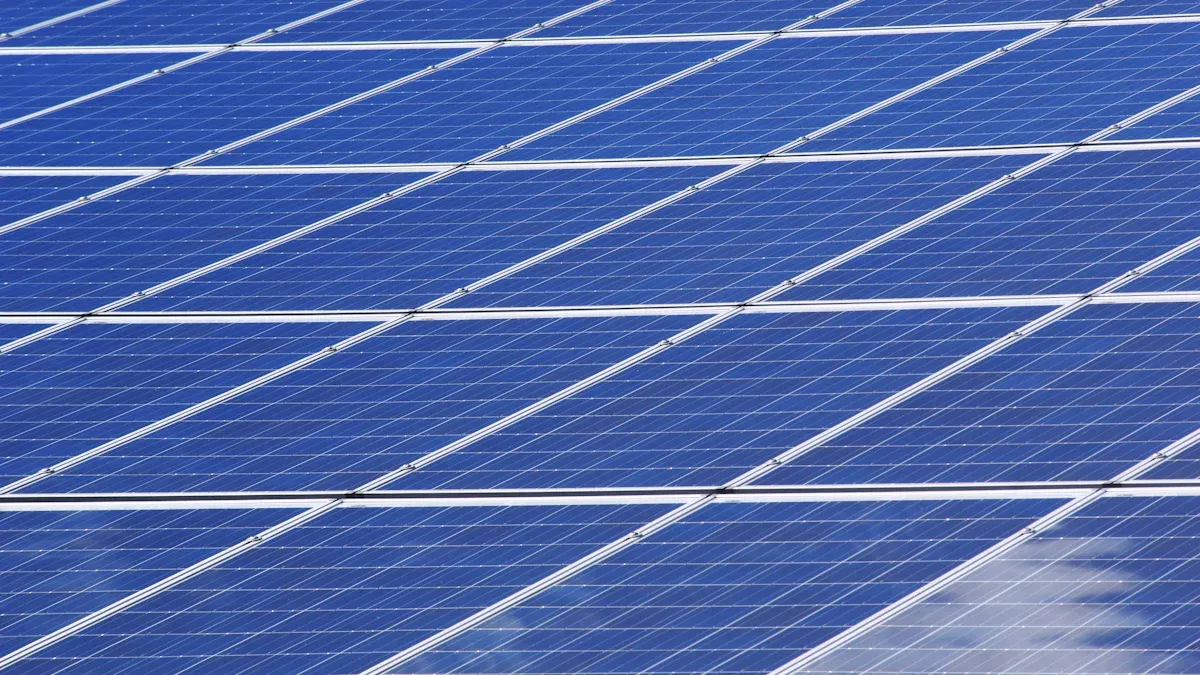
When you look at solar panel cost in 2025, you see a big drop compared to past years. In 2010, you would have paid about $8.70 per watt. By the end of 2024, the price dropped to $3.33 per watt. Now, in 2025, the average cost of solar is around $3.00 per watt. This means you get more power for your money than ever before.
The cost of solar panels per watt keeps going down as technology improves.
Most homeowners pay between $2 and $3 per watt for a new system.
The average cost of solar panels per watt depends on your location and the size of your system.
You can see from the chart below that the price per watt drops as you choose a bigger system. If you install a 4 kW system, you pay about $3.84 per watt. For a 10 kW system, the price drops to $2.90 per watt. Bigger systems usually mean better value.
System size | Avg cost per watt |
|---|---|
4 kW | $3.84 |
5 kW | $3.53 |
6 kW | $3.32 |
7 kW | $3.17 |
8 kW | $3.06 |
9 kW | $2.97 |
10 kW | $2.90 |
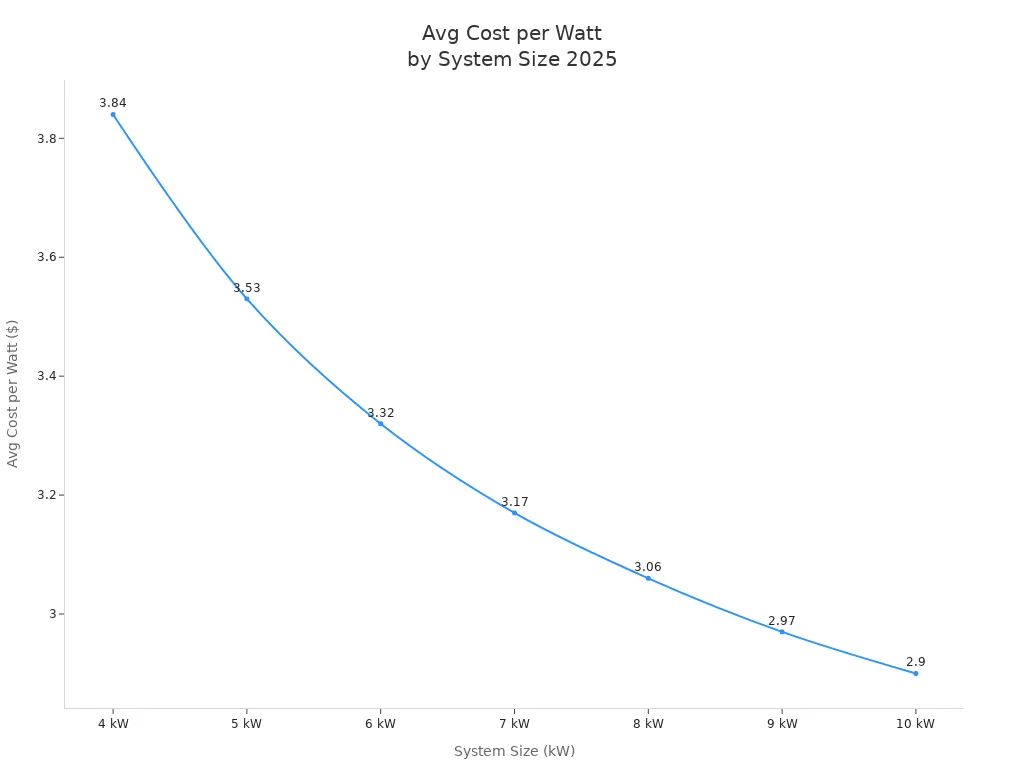
Tip: If you want the lowest solar panel cost per watt, consider installing a larger system if your roof and budget allow.
The total cost of solar panels depends on how much power you need. Most homes use systems between 5 kW and 8 kW. The average solar panel system for a home costs between $12,500 and $36,000 before incentives. After you apply the federal tax credit, you can expect to pay less.
Here’s a quick look at what you might pay for different system sizes in 2025:
System Size | Total Cost Before Incentives | Cost After Federal Tax Credit |
|---|---|---|
5 kW | $13,250 - $26,400 | $9,275 - $18,480 |
8 kW | $21,200 - $39,600 | $14,840 - $27,720 |
As you can see, the cost of solar panels goes up with system size, but the price per watt goes down. Most families find that a 7 kW or 8 kW system gives them enough power for daily needs. The average cost of solar for a typical home falls between $25,000 and $30,000 before incentives.
Solar panel costs by state can change a lot. Some states have higher labor costs or stricter building codes. Others have more sunshine or better incentives. Here’s a table showing which states have the highest and lowest average solar panel costs in 2025:
Rank | State | Average Cost ($/W) | Notes |
|---|---|---|---|
1 | Tennessee | $3.65 | Emerging market with higher costs |
2 | Colorado | $3.10 | High labor costs, mountain installations |
3 | Massachusetts | $3.00 | High labor costs, strict codes |
4 | Rhode Island | $2.95 | Small market, complex installations |
5 | Indiana | $2.90 | Limited market maturity |
1 | Arizona | $2.10-2.30 | Favorable conditions, established industry |
2 | Texas | $2.10-2.35 | Mature market, high competition |
3 | Florida | $2.35 | Strong solar policies, competition |
4 | Nevada | $2.55 | Growing market with competitive pricing |
5 | California | $2.70 | Largest market with economies of scale |
You might notice that states like Arizona and Texas have some of the lowest solar panel costs by state. These places have lots of sunshine, strong competition, and good incentives. On the other hand, states like Tennessee and Colorado have higher average solar panel costs because of labor and installation challenges.
High electricity rates make solar more attractive in places like California and New York.
State incentives can lower your upfront solar panel system costs.
The average cost of solar in the U.S. ranges from $20,000 to $30,000 before incentives, and $14,000 to $21,000 after the federal tax credit.
If you want to get the best deal, compare solar panel costs by state and look for local incentives. The average cost of solar panels can drop a lot if you live in a state with strong solar policies.
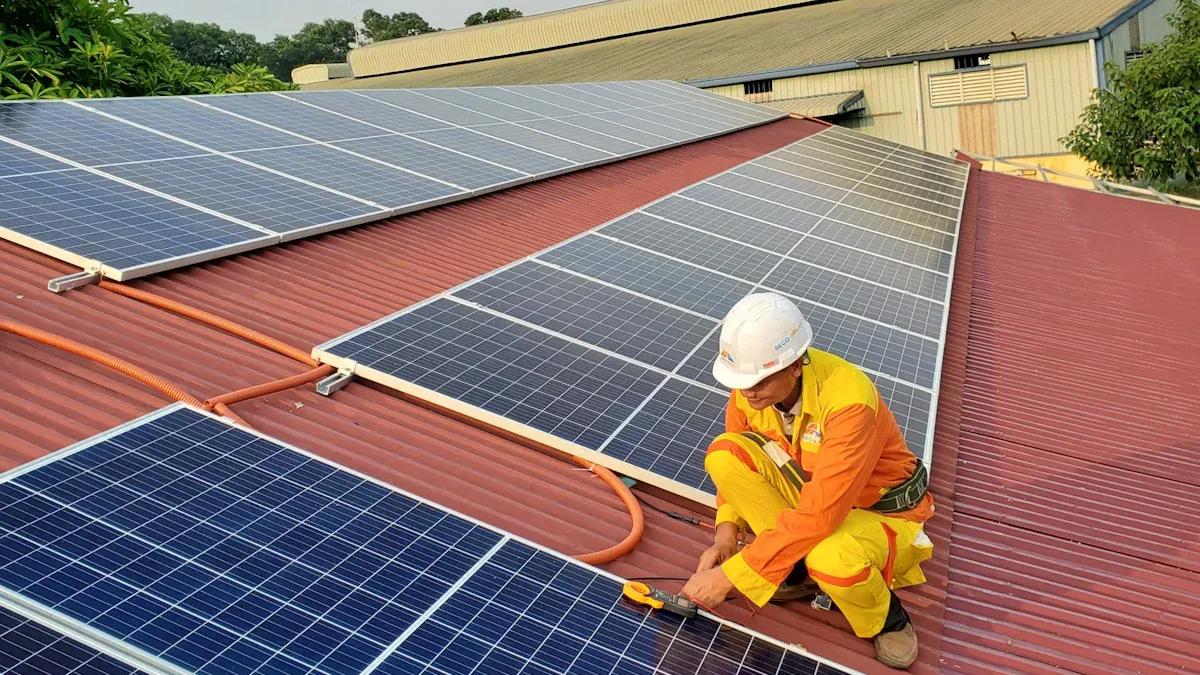
When you start looking at solar panels, the size of your system makes a big difference in what you pay. Bigger systems cost more overall, but you often get a better deal per watt. If you need more power for your home, you’ll probably choose a larger system. That means you’ll spend more upfront, but you might save more in the long run.
Here’s a quick look at how system size affects cost in 2025:
System Size | Average Cost Before Credits | Cost After 30% Tax Credit | Cost Per Watt |
|---|---|---|---|
5 kW | $14,850 | $10,395 | $2.97 |
7 kW | $19,670 | $13,769 | $2.81 |
10 kW | $27,300 | $19,110 | $2.73 |
12 kW | $31,800 | $22,260 | $2.65 |
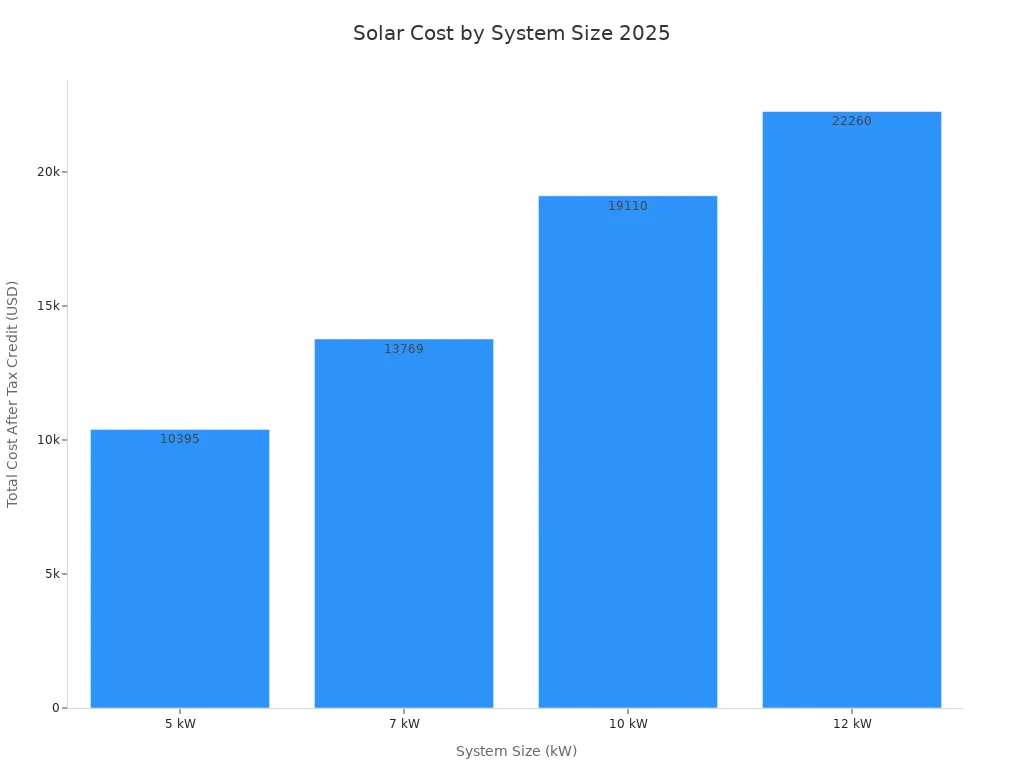
You might notice that the price per watt drops as you go bigger. If you have a small house, a 5 kW system could be enough. If you use lots of electricity, a 10 kW or 12 kW system might fit better. The tax credit helps lower your final cost, so don’t forget to factor that in.
Tip: If you want the best value, try to size your system based on your actual energy use. Oversizing can mean higher upfront costs without extra savings.
Where you live changes the price of solar panels more than you might think. Sunny states like California, Florida, and Arizona usually offer lower costs because you get more sunlight. That means your panels work harder and you need fewer of them. Local incentives also help cut your costs, but these vary from state to state.
Here are some things that affect solar prices in different locations:
Sunlight: More sun means better efficiency and lower costs.
Local incentives: Some states offer rebates or extra tax credits.
Labor rates: Installation costs go up in places with higher wages.
Building codes: Strict rules can add to your expenses.
Transportation: If you live far from suppliers, shipping costs may rise.
If you live in a state with strong solar policies, you’ll probably pay less. In areas with tough building codes or expensive labor, expect to pay more.
Not all solar panels are the same. The quality of your equipment changes both the price and how well your system works. Monocrystalline panels cost more, but they give you higher efficiency and longer warranties. Polycrystalline and thin-film panels are cheaper, but they don’t perform as well.
Monocrystalline panels: High efficiency, longer lifespan, higher price.
Polycrystalline panels: Lower cost, decent performance, shorter warranty.
Thin-film panels: Cheapest option, lowest efficiency.
If you want your system to last and produce more power, you might choose higher-quality panels. You can also lease panels, which means you pay for the power they make instead of buying the panels. Leasing can lower your upfront costs, but you’ll need to look at your long-term savings.
Note: Investing in better equipment often means fewer repairs and more savings over time. Choose panels that match your budget and energy needs.
When you think about the cost of going solar, you might focus on the price of the panels. But the installation process can make a big difference in your final bill. Solar panel installation is not a one-size-fits-all job. Your home’s unique features can make the process simple or much more complicated.
Let’s break down what affects the cost of installation:
Roof Size and Shape: If you have a large, flat roof, installers can work quickly and easily. A small or oddly shaped roof takes more time and planning. Installers may need to use special equipment or custom layouts, which can raise your costs.
Roof Pitch and Orientation: A roof with a 30-45° pitch that faces south is perfect for solar panels. You get the most sunlight, and the panels are easy to install. If your roof is steep, shaded, or faces another direction, the job gets harder. Installers might need to add extra supports or use special mounting systems.
Roof Condition and Type: If your roof is old or damaged, you may need repairs before installing solar panels. Some roofing materials, like clay tiles or metal, are harder to work with. This can add time and money to your project.
Shading and Levels: Trees, chimneys, or nearby buildings can cast shadows on your roof. If your roof has multiple levels or lots of obstacles, installers need to design a custom solution. This often means higher labor costs and more complex wiring.
Permitting and Local Rules: Every city and neighborhood has its own rules for solar panel installation. Some places require extra permits or inspections. Homeowners associations (HOAs) might have their own restrictions. These steps can slow down your project and add to your costs. In some cases, two homes with the same system can see a price difference of $4,000 just because of local rules.
Tip: Before you start your solar journey, check your roof’s condition and ask your installer about local permitting. Planning ahead can help you avoid surprises and keep your project on budget.
You might notice that while the price of solar panels keeps dropping, the cost of labor and permits is going up in many areas. This means the installation part of your solar project can take up a bigger share of your total spending. If you want to save money, look for experienced installers who know your area well. They can help you find the best way to set up your system and handle any tricky parts of the job.
Solar panel installation is a big step, but understanding what affects the price can help you make smart choices. Take time to review your roof, talk to local experts, and plan for any extra costs that might come up. That way, you’ll get the most value from your solar investment.
You can save a lot on your solar panel installation cost thanks to the federal tax credit. In 2025, the government lets you claim 30% of your total solar project cost as a tax credit. This program is called the Residential Clean Energy Credit. If your system costs $30,000, you can get $9,000 back when you file your taxes. That means your cost after federal tax credit drops to $21,000. When you add in state and local incentives, your final price could go even lower—sometimes as little as $5,000.
This tax credit makes a big difference. You pay the cost before federal tax credit, but after you claim the credit, your real expense is much less. Many homeowners see savings between $3,000 and $9,000 just from this one program.
Tip: You must own your solar system to claim the federal tax credit. If you lease, you can’t use this benefit.
You can find even more savings with state and local programs. Some states offer rebates, grants, or special credits that lower your cost of installing residential solar systems. These programs work with the federal tax credit to make solar more affordable.
Here’s a quick look at some top state incentives in 2025:
State | Incentive Type | Amount/Details |
|---|---|---|
Delaware | Green Energy Program | $0.70 per watt (up to $6,000) |
Maryland | Targeted Grants | $1,000 grants for certain projects |
New Jersey | SREC Markets | Earn credits for solar production |
Pennsylvania | Net Metering | Get credit for extra power you make |
Virginia | Tax Exemptions | No property tax on solar upgrades |
States like Delaware and Maryland help you cut your cost before federal tax credit with rebates or grants. After you apply both state and federal programs, your cost after federal tax credit can drop much lower than the national average.
Some states offer cash rebates right after installation.
Others give you credits for the energy your panels produce.
A few states even let you skip property taxes on your new solar system.
Note: State programs change often. Check with your local energy office or installer to see what’s available in your area.
You have several ways to pay for your solar panel installation. Your choice can change how much you spend over time, even if the starting price stays the same.
Loans: You can borrow money to pay for your system. If you pick a loan with a high interest rate or a long term, you might pay much more in the end. Zero-down loans sound great, but they sometimes hide extra costs.
Leasing: You can lease your panels or sign a Power Purchase Agreement (PPA). This lowers your upfront cost and shifts some risk to the company that owns the panels. You pay for the power you use, not the panels themselves.
Cash Purchase: If you pay cash or use a home equity line of credit (HELOC), you avoid interest charges. This usually gives you the best long-term savings.
Financing does not change your cost before federal tax credit, but it affects your total payments over time.
High-interest loans or long repayment plans can make your solar panel installation cost much higher.
Leasing and PPAs lower your upfront cost, but you may save less in the long run.
Tip: Always compare your options. Ask your installer to show you the total cost for each financing method, not just the monthly payment.
When you think about solar panels, you might picture them as a set-it-and-forget-it upgrade. In reality, you need to plan for some yearly maintenance. Most systems work well with just a little care, but you should still budget for cleaning, inspections, and the occasional repair.
The average annual maintenance cost for solar panels in 2025 is about $520.
Most homeowners spend between $390 and $720 each year.
Some people pay as little as $150, while others see costs up to $850.
If you have a typical 6kW system, your yearly bill could be under $200.
Many homeowners report spending $150 to $300 per year for basic upkeep.
You might only need to clean your panels once or twice a year, especially if you live in a dusty area. Sometimes, you’ll want a pro to check your system for loose wires or worn parts. If you spot a drop in your energy production, a quick inspection can help you fix the problem before it gets worse.
Tip: Keep your panels clean and schedule a yearly checkup. This helps your system last longer and keeps your savings on track.
Before you can install solar panels, you need to get the right permits from your city or county. These permits make sure your system meets safety rules and local building codes. Permitting might sound simple, but it can add time and money to your project.
The maximum permitting fee for a home solar system is $450 in 2025.
For businesses, the cap is $1,000, with extra fees for bigger projects.
Permitting fees are part of the “soft costs” of solar. These soft costs can make up more than half of your total installation price.
Some places move quickly, while others take weeks to approve your project. If your area has strict rules or lots of paperwork, you might pay more in fees and wait longer to start saving with solar.
Note: Ask your installer about local permitting. They can help you avoid delays and surprise costs.
You might want to upgrade your solar system in the future. Many homeowners add battery storage so they can use solar power at night or during outages. Upgrades like these can boost your energy independence, but they come with extra costs.
Home battery storage systems cost between $6,000 and $23,000 for homes and small businesses.
A standard 11.4 kWh battery runs about $9,041.
Labor for installation usually adds $1,000 to $2,000.
Extra equipment, like inverters or wiring, can cost another $1,000 to $1,500.
Most residential battery systems fall in the $8,000 to $18,000 range.
Lithium-ion batteries, the most popular choice, cost around $10,000 for a 10 kWh setup.
Lead-acid batteries are cheaper at first but need more maintenance.
Flow and solid-state batteries cost more upfront but can save you money over time.
If you plan to add storage or upgrade your system, talk with your installer about the best options for your needs and budget. Upgrades can help you get more from your solar investment, but it’s smart to know the costs before you decide.
Thinking about batteries? They can give you peace of mind during blackouts, but make sure you understand the price tag before you commit.
When you think about going solar, you probably picture lower electric bills and more control over your energy. Utility fees can surprise you, though. These costs show up after you install your panels and connect to the grid. You need to know about them before you make a decision.
Most utility companies charge you for connecting your solar system to the grid. This is called an interconnection fee. You pay this fee once, usually when your installer sets up your system. The price can range from $100 to $500, depending on where you live. Some places charge more if your system is large or if your home needs extra upgrades.
After you connect, you might see grid usage charges on your monthly bill. Utilities call these fees by different names. You might see “capacity charges,” “standby fees,” or “minimum bills.” These charges cover the cost of keeping your home linked to the grid, even if you use less electricity. In 2025, these fees are going up. Recent changes in capacity prices, like those from the PJM Interconnection auction, mean you could pay more each month. Businesses feel this increase the most, but homeowners notice it too.
Here’s a quick look at common utility fees you might face:
Fee Type | Typical Cost (2025) | What It Covers |
|---|---|---|
Interconnection | $100 - $500 | Grid connection setup |
Grid Usage | $10 - $40/month | Staying linked to the grid |
Standby/Capacity | $5 - $25/month | Backup power availability |
Net Metering Admin | $5 - $15/month | Metering and billing |
Tip: Ask your utility company for a full list of solar-related fees before you sign up. This helps you avoid surprises and plan your budget.
You might wonder why these fees exist. Utilities use them to pay for the wires, transformers, and backup power that keep your lights on. Even if your panels make most of your electricity, you still rely on the grid at night or during cloudy days. These fees help cover those costs.
Some homeowners feel frustrated by these charges. You install solar to save money, but fees can eat into your savings. If you add battery storage, you can use more of your own power and depend less on the grid. This helps you lower your utility fees over time.
You should also watch for changes in local rules. Some states update their fee structures every year. If you live in an area with high grid usage charges, solar panels and batteries can help you avoid peak rates and keep your bills low.
Note: Utility fees are part of the hidden costs of solar. They don’t stop you from saving money, but you need to include them in your calculations. Smart planning helps you get the most out of your solar investment.
You probably want to know how long it takes to get your money back after installing solar panels. This is called the payback period. Most homeowners in 2025 see a payback period between 9 and 12 years. That means after about a decade, your solar panels have paid for themselves through the money you save on electricity bills.
Here are some things that affect your payback period:
Where you live. Sunny states or places with high electricity rates help you pay off your system faster.
Local incentives. Rebates and tax credits can shorten your payback time.
System size and cost. Bigger systems cost more but can save you more, too.
Some states stand out. If you live in Hawaii or Massachusetts, you might see your payback period drop to just 5 years. In other places, like Louisiana or North Dakota, it could stretch to 16 years or more. Your payback period depends on your unique situation, but most people find it reasonable.
Tip: Check your local electricity rates and incentives. They can make a big difference in how quickly you see returns.
When you install solar panels, you start saving money right away. On average, you can expect to save about $1,500 each year on your electricity bills in 2025. That’s money you keep in your pocket instead of sending to your utility company.
These savings add up over time. If your payback period is 10 years, you could save $15,000 by then. After that, your panels keep working, and your savings keep growing. Many homeowners use these savings for other home upgrades or even a family vacation.
Note: Your actual savings may be higher if your electricity rates go up or if you use more power during the day.
You might wonder if solar panels are a good investment. The answer is yes for most people. The return on investment (ROI) for residential solar systems in 2025 usually falls between 10% and 15%. That’s better than many savings accounts or CDs.
Here’s how ROI looks for different types of solar systems:
Residential systems: 10-15% ROI
Commercial systems: 12-18% ROI
Industrial systems: 15-20% ROI
Let’s look at a real-life example. A family with a 7 kW system in Germany saves about €1,200 each year and gets their money back in less than 8 years. In California, an office with a large solar setup can see a 12-18% ROI and recover their costs in 6-7 years, thanks to high power needs and strong incentives.
Solar panels give you steady returns and help protect you from rising energy prices. If you want a smart, long-term investment, solar is worth a close look.
When you think about going solar, you probably picture savings and energy freedom. But every investment comes with risks. You should know what could affect your solar project in 2025. Let’s break down the main risks you might face:
Risk Type | Description |
|---|---|
Changes in Tax Credits | New laws could deny leasing companies access to important tax credits, which may affect your savings. |
Supply Chain Dependencies | Many solar parts come from overseas. If there are problems with shipping or trade, your project could get delayed or cost more. |
Climate Change Impact | Extreme weather, like storms or heat waves, can damage solar panels or slow down installation. |
You might wonder why tax credits matter so much. Right now, the federal government gives you a big tax break for installing solar. If lawmakers change these rules, you could lose out on thousands of dollars. In fact, 84% of investors say they would put less money into solar if tax credits become uncertain. Developers feel the same way. About 73% would slow down or stop new projects if the rules change.
Supply chain issues are another big risk. Most solar panels and parts come from Southeast Asia. If there are problems with shipping, trade wars, or new tariffs, you could see higher prices or long waits for your equipment. Sometimes, new laws pull project deadlines forward, which can make planning harder. You might have to rush your decision or miss out on the best deals.
Climate change also plays a role. You might think solar panels help fight climate change, and they do. But stronger storms, floods, or heat waves can damage your panels or make it hard for workers to install them. This could mean extra repair costs or delays in getting your system up and running.
Here are a few more things to watch out for:
Tariffs on imported panels could make your project more expensive.
If electricity rates keep rising (about 7% each year), solar becomes more valuable, but you still need to watch your budget.
Local rules and utility fees can change, sometimes without much warning.
Note: You can lower your risk by working with a trusted installer, keeping up with local news, and asking lots of questions before you sign any contracts.
Solar is still a smart choice for many people in 2025. But you should go in with your eyes open. Knowing the risks helps you plan better and get the most out of your investment. If you stay informed and flexible, you can handle most surprises that come your way.
When you start shopping for solar panels, you’ll notice that quotes from different installers can look very different. You might wonder why one company charges more than another. It’s not just about the price tag. You need to look at what’s included in each offer.
Check the quality of the equipment. Some installers use high-efficiency panels, while others use basic models.
Look at the warranties. Good installers offer strong warranties for both the panels and the work.
Ask about maintenance plans. Some companies include yearly checkups or cleaning in their price.
Compare the cost per watt. This helps you see how much you’re paying for the power you get.
If you want to know how much do solar panels cost, don’t just pick the lowest number. A cheap quote might leave out important services or use lower-quality parts. Take your time and ask questions. You’ll get a better deal and avoid surprises later.
Tip: Always review what’s included in each quote. A higher price might mean better support and longer-lasting equipment.
Picking the right installer can make your solar project go smoothly. You want someone who knows what they’re doing and stands behind their work. Here’s how you can find a reputable company:
Verify certifications. Look for installers with NABCEP certification. This shows they have special training.
Check licensing and insurance. Make sure the company is allowed to work in your state and has insurance.
Read reviews and get recommendations. Search for customer feedback on trusted sites.
Request a written contract. Ask for a detailed agreement that lists all terms and warranties.
Be skeptical of deals that sound too good to be true. If the price is much lower than others, something might be missing.
Choose an established company. Pick a provider with a good track record and industry memberships.
You want your solar installation costs to be fair, but you also want peace of mind. A good installer will answer your questions and help you understand every step.
Note: Don’t rush your decision. Spend time researching and talking to different companies before you choose.
You might ask, “When is the best time to buy solar panels?” Timing can help you save money and get better incentives. In 2025, the best months to buy are January through March. Manufacturers have limited production and lower inventory, so you can find good deals.
Buy early in the year to take advantage of federal tax credits and state rebates.
These incentives can cut your costs by 45-55%. You’ll see a faster payback period and a better return on investment.
If you wait too long, you might miss out on rebates or face higher prices as demand goes up.
If you want to know how much do solar panels cost, remember that timing matters. Plan ahead and talk to your installer about current incentives.
Tip: Ask your installer about upcoming rebates and deadlines. Acting early can help you lock in the best price.
Solar panels in 2025 cost about $17,823 before incentives. The price changes depending on your state and system size. Arizona has the lowest average cost. Hawaii has the highest cost. Solar panels cost between $7 and $10 for each square foot. You can lower your upfront costs with tax credits. Free tools and solar loans also help you save money. Using solar with efficient appliances helps you save even more.
Metric | Value |
|---|---|
Payback period | 7.1 years |
Typical ROI | 10–20% annually |
Lifetime savings | $31,000–$100,000 |
Home value increase | 6.9% |
Solar panels help you save money for many years. They give you strong returns. If you compare your choices and use incentives, you get the best deal for your home.
Most solar panels last 25 to 30 years. You can expect them to keep making power even after that, just at a lower rate. Regular cleaning and yearly checkups help your panels last longer.
Yes, your panels still work when it’s cloudy. They make less power, but you’ll still see some savings. You don’t need full sun every day to benefit from solar.
You can try, but it’s not easy. Most people hire a pro. Installers know how to handle wiring, permits, and safety rules. You’ll get better results and a warranty if you use a certified installer.
You have two choices:
Sell your home with the panels included.
Take the panels with you (but this costs extra). Most buyers like homes with solar, so you may get a higher sale price.
Yes! Studies show homes with solar sell for more. On average, you could see a 4% to 7% boost in value. Buyers like lower energy bills and green upgrades.
You should clean your panels once or twice a year. Schedule a yearly inspection to check for loose wires or dirt. Most systems need very little care.
Solar is safe, but you should watch for roof leaks, wiring issues, or changes in local rules. Pick a trusted installer and ask about warranties to lower your risk.